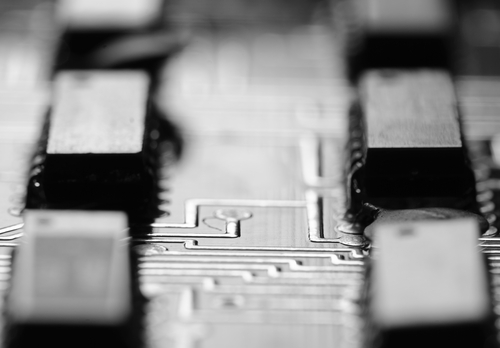 The microelectronic sensors and mechanical systems built into smartphone cameras and other tiny electronic devices may soon evolve into microscopic, custom-printed versions designed as bionic body parts rather than smartphone components. Engineering researchers at Tel Aviv University have developed a micro-printing process that can build microscopic microelectromechanical systems (MEMS) onto a flexible, non-toxic organic polymer designed for implantation in the human body. Current-generation MEMS are typically found in the accelerometers in smartphones, or the tiny actuator motors that focus cell-phone camera lenses. Most are made from substrates based on silicon, and built using techniques common to semiconductor fabrication. The new process, as described in the journal Microelectronic Engineering, relies on an organic polymer that is hundreds of times more flexible than conventional materials used for similar purposes. That flexibility not only makes the units easier to fit into the oddly shaped parts of a human body, it allows them to be made more sensitive to motion and energy-efficient. That alone would give a boost to the miniaturization of electronics, but the stretch and flex of the new materials could also serve as more comfortable and efficient replacements for current prosthetics that sense stimuli from an amputee's nervous system to power a prosthetic arm, for example, or operate a synthetic bladder. In the datacenter context, super-flexible and sensitive materials could help make the next generation of hardware more efficient. The holdup right now is that the sensors and actuators have to be made out of materials less flexible than the polymer substrate, according to a Tel Aviv University announcement of the experiment. The next step is to print functioning sensors and actuators from the flexible polymer, which would allow for the production of complete, sophisticated integrated sensors, circuits and activators that could be as flexible as the skin and muscle in which they are embedded. Coincidentally, researchers at the Leibniz Institute for Solid State and Materials Research in Dresden published a paper this week describing a technique that produces a micro-supercapacitor that is flexible, only nanometers thick, and can be used to create a power supply less than half a centimeter across. Supercapacitors can store almost as much energy as a battery, but charge and discharge much more quickly, so they're a big advantage in microcircuit electronics. The cost of supercapacitors made from carbon or conducting polymers can be too high to be practical, but the German researchers found a way to vaporize manganese dioxide and allow it to precipitate onto thin bendy films embedded with thin layers of gold, to improve electrical conductivity. The resulting power supply is flexible, tiny and can store-and-deliver more power per unit than the best supercapacitors on the market today, according to an announcement of the result, which was published this week in the British journal Energy & Environmental Science. Neither development is likely to show up in the next Samsung smartphone, but neither is far from practicality, either. Both techniques could be used for either bionics or mobile systems as soon as efficient manufacturing techniques can be developed to incorporate them. Image: pavelgr/Shutterstock.com
The microelectronic sensors and mechanical systems built into smartphone cameras and other tiny electronic devices may soon evolve into microscopic, custom-printed versions designed as bionic body parts rather than smartphone components. Engineering researchers at Tel Aviv University have developed a micro-printing process that can build microscopic microelectromechanical systems (MEMS) onto a flexible, non-toxic organic polymer designed for implantation in the human body. Current-generation MEMS are typically found in the accelerometers in smartphones, or the tiny actuator motors that focus cell-phone camera lenses. Most are made from substrates based on silicon, and built using techniques common to semiconductor fabrication. The new process, as described in the journal Microelectronic Engineering, relies on an organic polymer that is hundreds of times more flexible than conventional materials used for similar purposes. That flexibility not only makes the units easier to fit into the oddly shaped parts of a human body, it allows them to be made more sensitive to motion and energy-efficient. That alone would give a boost to the miniaturization of electronics, but the stretch and flex of the new materials could also serve as more comfortable and efficient replacements for current prosthetics that sense stimuli from an amputee's nervous system to power a prosthetic arm, for example, or operate a synthetic bladder. In the datacenter context, super-flexible and sensitive materials could help make the next generation of hardware more efficient. The holdup right now is that the sensors and actuators have to be made out of materials less flexible than the polymer substrate, according to a Tel Aviv University announcement of the experiment. The next step is to print functioning sensors and actuators from the flexible polymer, which would allow for the production of complete, sophisticated integrated sensors, circuits and activators that could be as flexible as the skin and muscle in which they are embedded. Coincidentally, researchers at the Leibniz Institute for Solid State and Materials Research in Dresden published a paper this week describing a technique that produces a micro-supercapacitor that is flexible, only nanometers thick, and can be used to create a power supply less than half a centimeter across. Supercapacitors can store almost as much energy as a battery, but charge and discharge much more quickly, so they're a big advantage in microcircuit electronics. The cost of supercapacitors made from carbon or conducting polymers can be too high to be practical, but the German researchers found a way to vaporize manganese dioxide and allow it to precipitate onto thin bendy films embedded with thin layers of gold, to improve electrical conductivity. The resulting power supply is flexible, tiny and can store-and-deliver more power per unit than the best supercapacitors on the market today, according to an announcement of the result, which was published this week in the British journal Energy & Environmental Science. Neither development is likely to show up in the next Samsung smartphone, but neither is far from practicality, either. Both techniques could be used for either bionics or mobile systems as soon as efficient manufacturing techniques can be developed to incorporate them. Image: pavelgr/Shutterstock.com Super-Flexible Circuits Could Boost Smartphones, Bionic Limbs
 The microelectronic sensors and mechanical systems built into smartphone cameras and other tiny electronic devices may soon evolve into microscopic, custom-printed versions designed as bionic body parts rather than smartphone components. Engineering researchers at Tel Aviv University have developed a micro-printing process that can build microscopic microelectromechanical systems (MEMS) onto a flexible, non-toxic organic polymer designed for implantation in the human body. Current-generation MEMS are typically found in the accelerometers in smartphones, or the tiny actuator motors that focus cell-phone camera lenses. Most are made from substrates based on silicon, and built using techniques common to semiconductor fabrication. The new process, as described in the journal Microelectronic Engineering, relies on an organic polymer that is hundreds of times more flexible than conventional materials used for similar purposes. That flexibility not only makes the units easier to fit into the oddly shaped parts of a human body, it allows them to be made more sensitive to motion and energy-efficient. That alone would give a boost to the miniaturization of electronics, but the stretch and flex of the new materials could also serve as more comfortable and efficient replacements for current prosthetics that sense stimuli from an amputee's nervous system to power a prosthetic arm, for example, or operate a synthetic bladder. In the datacenter context, super-flexible and sensitive materials could help make the next generation of hardware more efficient. The holdup right now is that the sensors and actuators have to be made out of materials less flexible than the polymer substrate, according to a Tel Aviv University announcement of the experiment. The next step is to print functioning sensors and actuators from the flexible polymer, which would allow for the production of complete, sophisticated integrated sensors, circuits and activators that could be as flexible as the skin and muscle in which they are embedded. Coincidentally, researchers at the Leibniz Institute for Solid State and Materials Research in Dresden published a paper this week describing a technique that produces a micro-supercapacitor that is flexible, only nanometers thick, and can be used to create a power supply less than half a centimeter across. Supercapacitors can store almost as much energy as a battery, but charge and discharge much more quickly, so they're a big advantage in microcircuit electronics. The cost of supercapacitors made from carbon or conducting polymers can be too high to be practical, but the German researchers found a way to vaporize manganese dioxide and allow it to precipitate onto thin bendy films embedded with thin layers of gold, to improve electrical conductivity. The resulting power supply is flexible, tiny and can store-and-deliver more power per unit than the best supercapacitors on the market today, according to an announcement of the result, which was published this week in the British journal Energy & Environmental Science. Neither development is likely to show up in the next Samsung smartphone, but neither is far from practicality, either. Both techniques could be used for either bionics or mobile systems as soon as efficient manufacturing techniques can be developed to incorporate them. Image: pavelgr/Shutterstock.com
The microelectronic sensors and mechanical systems built into smartphone cameras and other tiny electronic devices may soon evolve into microscopic, custom-printed versions designed as bionic body parts rather than smartphone components. Engineering researchers at Tel Aviv University have developed a micro-printing process that can build microscopic microelectromechanical systems (MEMS) onto a flexible, non-toxic organic polymer designed for implantation in the human body. Current-generation MEMS are typically found in the accelerometers in smartphones, or the tiny actuator motors that focus cell-phone camera lenses. Most are made from substrates based on silicon, and built using techniques common to semiconductor fabrication. The new process, as described in the journal Microelectronic Engineering, relies on an organic polymer that is hundreds of times more flexible than conventional materials used for similar purposes. That flexibility not only makes the units easier to fit into the oddly shaped parts of a human body, it allows them to be made more sensitive to motion and energy-efficient. That alone would give a boost to the miniaturization of electronics, but the stretch and flex of the new materials could also serve as more comfortable and efficient replacements for current prosthetics that sense stimuli from an amputee's nervous system to power a prosthetic arm, for example, or operate a synthetic bladder. In the datacenter context, super-flexible and sensitive materials could help make the next generation of hardware more efficient. The holdup right now is that the sensors and actuators have to be made out of materials less flexible than the polymer substrate, according to a Tel Aviv University announcement of the experiment. The next step is to print functioning sensors and actuators from the flexible polymer, which would allow for the production of complete, sophisticated integrated sensors, circuits and activators that could be as flexible as the skin and muscle in which they are embedded. Coincidentally, researchers at the Leibniz Institute for Solid State and Materials Research in Dresden published a paper this week describing a technique that produces a micro-supercapacitor that is flexible, only nanometers thick, and can be used to create a power supply less than half a centimeter across. Supercapacitors can store almost as much energy as a battery, but charge and discharge much more quickly, so they're a big advantage in microcircuit electronics. The cost of supercapacitors made from carbon or conducting polymers can be too high to be practical, but the German researchers found a way to vaporize manganese dioxide and allow it to precipitate onto thin bendy films embedded with thin layers of gold, to improve electrical conductivity. The resulting power supply is flexible, tiny and can store-and-deliver more power per unit than the best supercapacitors on the market today, according to an announcement of the result, which was published this week in the British journal Energy & Environmental Science. Neither development is likely to show up in the next Samsung smartphone, but neither is far from practicality, either. Both techniques could be used for either bionics or mobile systems as soon as efficient manufacturing techniques can be developed to incorporate them. Image: pavelgr/Shutterstock.com 
